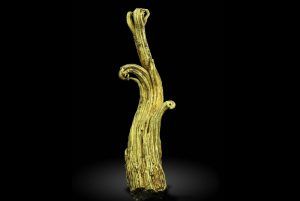The Ultra Rare Ram’s Horn Wire Gold Specimen
Posted onGold is a commodity. This means that one ounce of pure gold found in the U.S. is worth the same as one ounce of pure gold found in Russia. The value is consistent across the globe. This consistency is part of the appeal of gold. It is a fungible, meaning that it doesn’t matter whether you have a gold coin, bar, or ingot. As long as the purity and the weight are identical it’s all worth the same amount. Or is it?
A peculiar discovery in the Ground Hog mine in Colorado in 1887 challenged that thinking.
Miners were astounded when they found a deposit of gold that looked like a braid of icing piped out of a pastry bag. Others thought it looked like a ram’s horn. Something was different about the way this deposit formed. It was not a nugget like most gold. “It’s truly a unique object—there’s nothing even comparable to it,” explains John Rakovan, a mineralogist working at Miami University in Ohio. In fact, Rakovan estimates that there are only a few specimens of this kind in the world.
The “branch” of gold is small. It is a 263-gram, 4.7 inch piece. Based on current spot prices the value of the gold within would be worth about $12,744. However, the rarity of the formation completely changes its value. As Rakovan said, the Ram’s Horn gold specimen is worth “a very pretty penny.” He declined to offer a number. Most of those who have studied the piece professionally are scared to cite a dollar value for fear of prompting a theft.
The strange shape has sparked much speculation about its atomic structure. Gold deposits often have rounded, dull edges and corners resulting from the effects of water against the surface.
Experts describe this piece as a crystalline structure. For decades scientists have wondered how the piece formed. Getting answers would mean cutting into the piece and destroying what makes it so unique. However, new technology may provide new insight into the geological wonder.
Recently, physicists at Los Alamos National Laboratory’s neutron science center began exploring new ways to examine the gold without damaging the piece. Their solution was to bombard the Ram’s Horn with neutrons. This approach is used to reveal the number of crystals present in a structure. After high-security transportation to the lab the experiment determined that the formation consisted of just a few crystals.
Rakovan and others believe that these results can shed new light on our understanding of geochemical processes at work in gold formation.
The rarity of the Ram’s Horn wire gold specimen also suggests that not all gold is the same. The ounces of gold in this piece are not like anything else. What makes the Ram’s Horn so valuable is that its origins still baffle scientists. Though the neutron experiment has provided answers, scientists still have a long way to go before they achieve a complete understanding of how the Earth creates such wonders.
Today the Ram’s Horn is stored at Harvard’s Mineralogical and Geological Museum.
Ram’s Horn wire gold specimen. Photo Courtesy LACD
Sign up for our newsletter! Get our tales from the vault, our favorite stories from around the world and the latest tangible assets news delivered to your inbox weekly.










